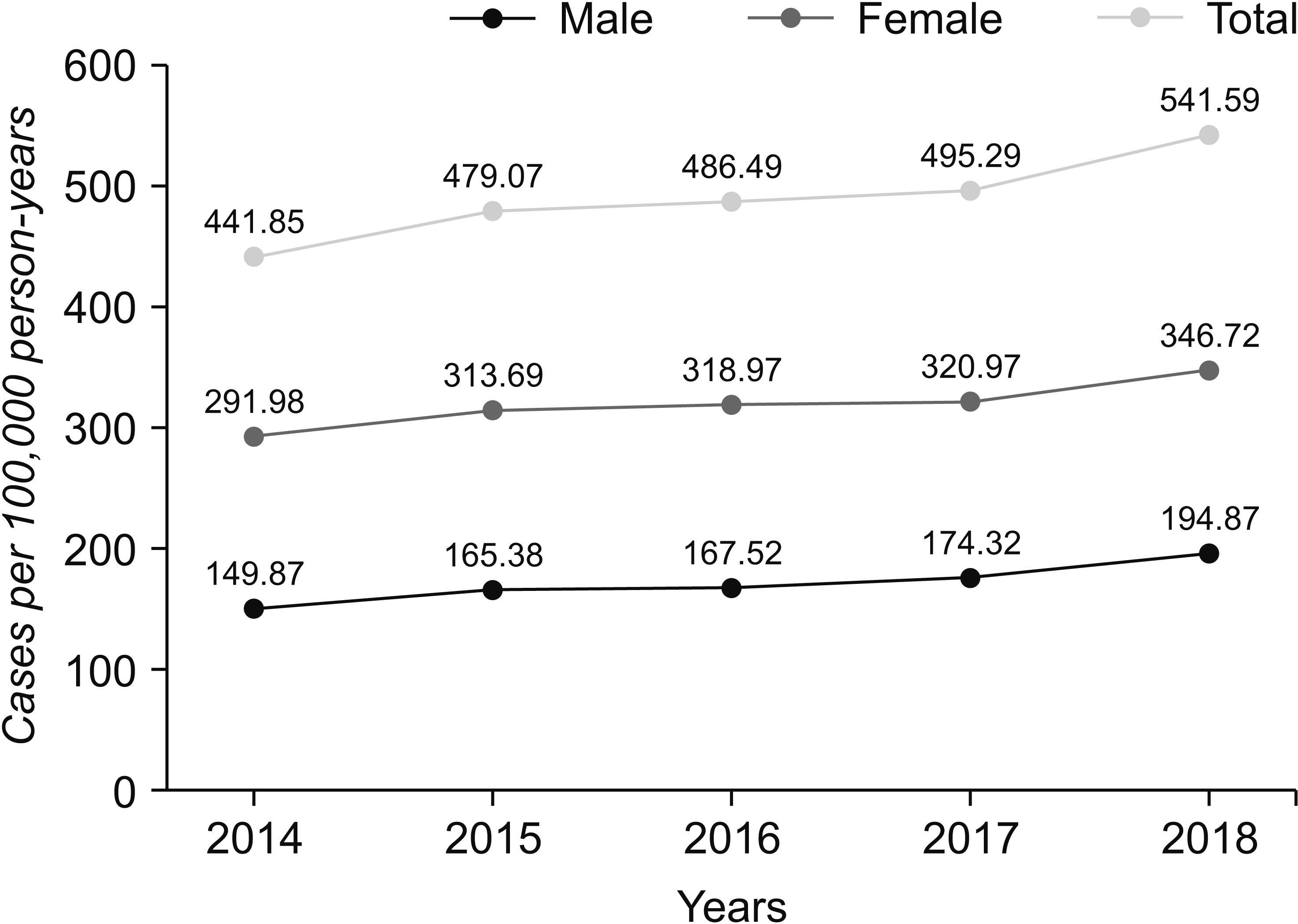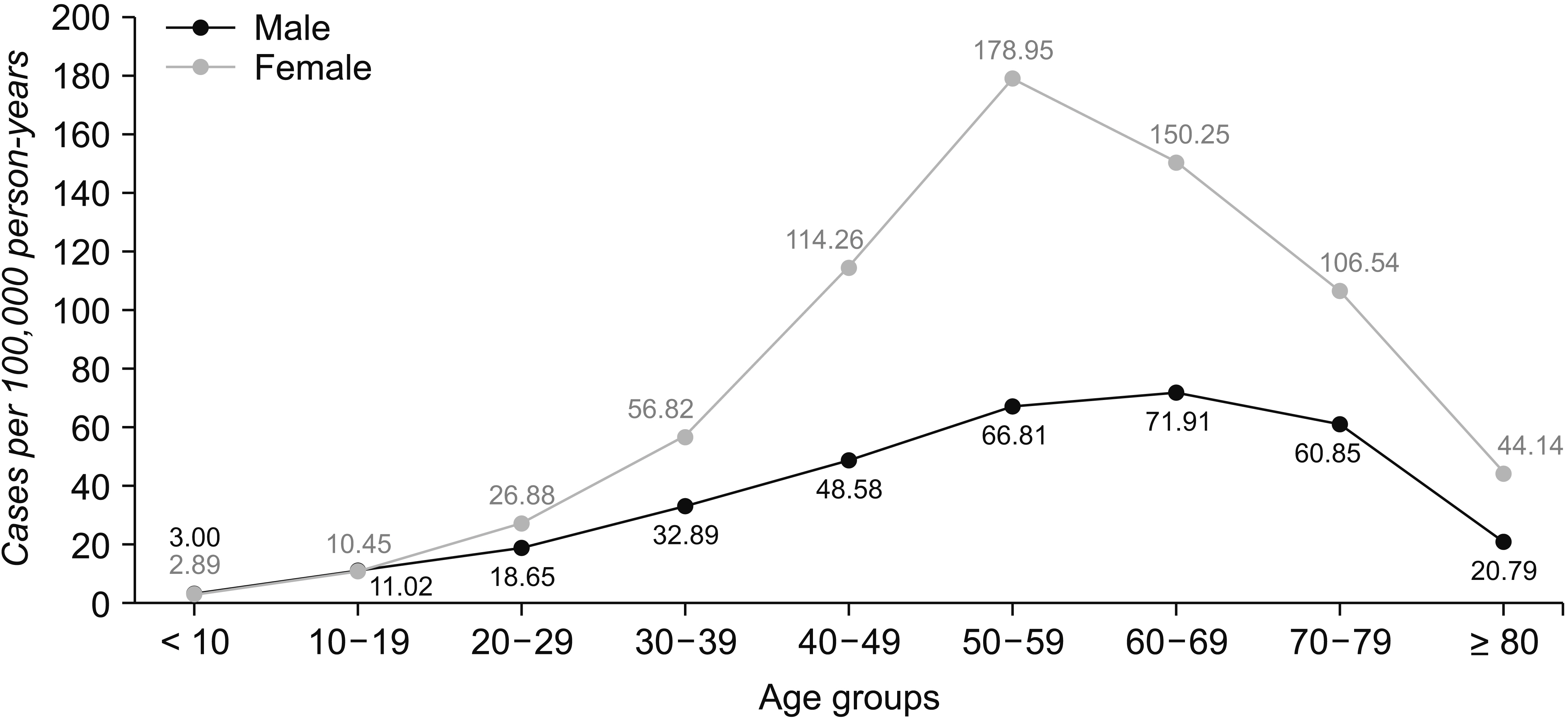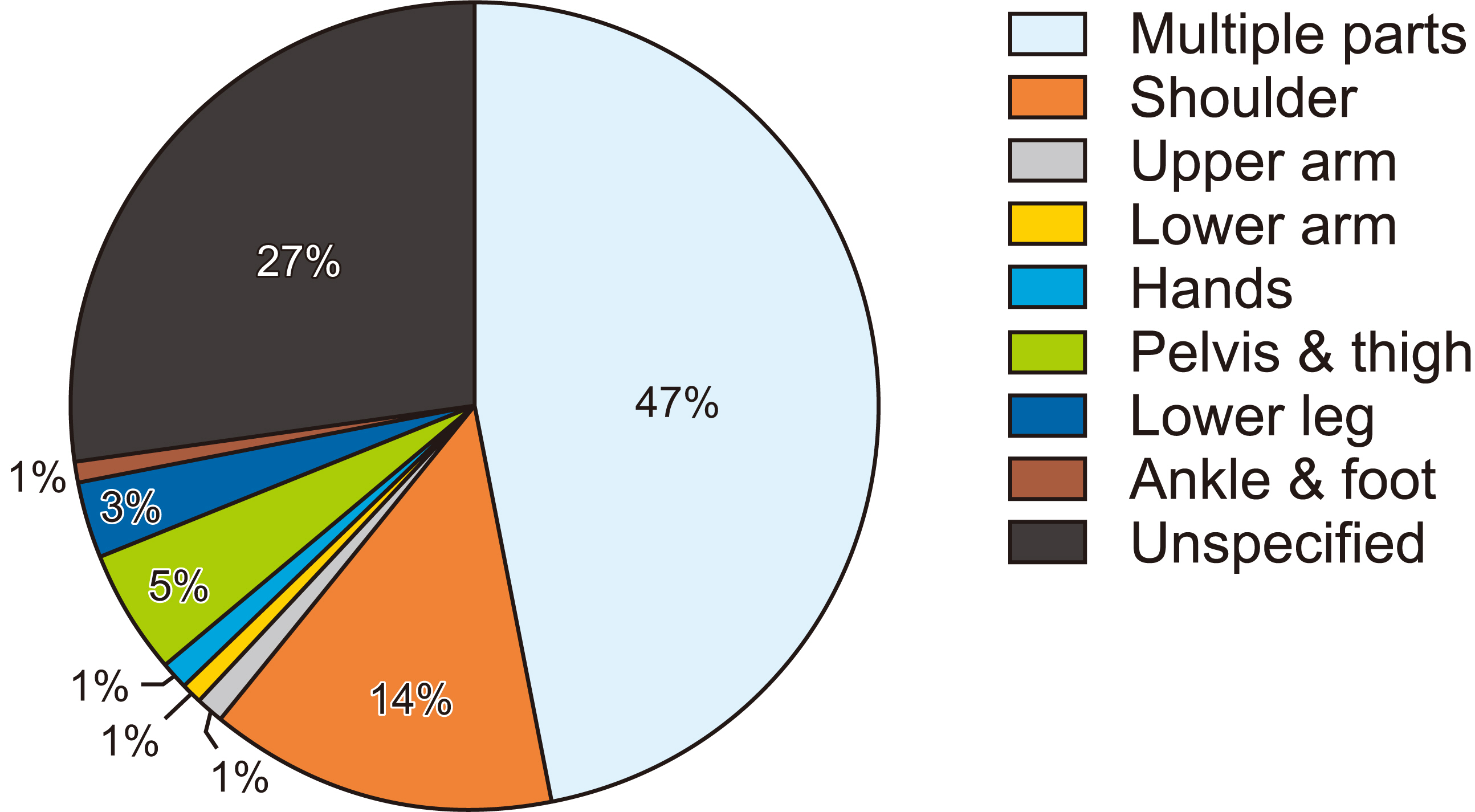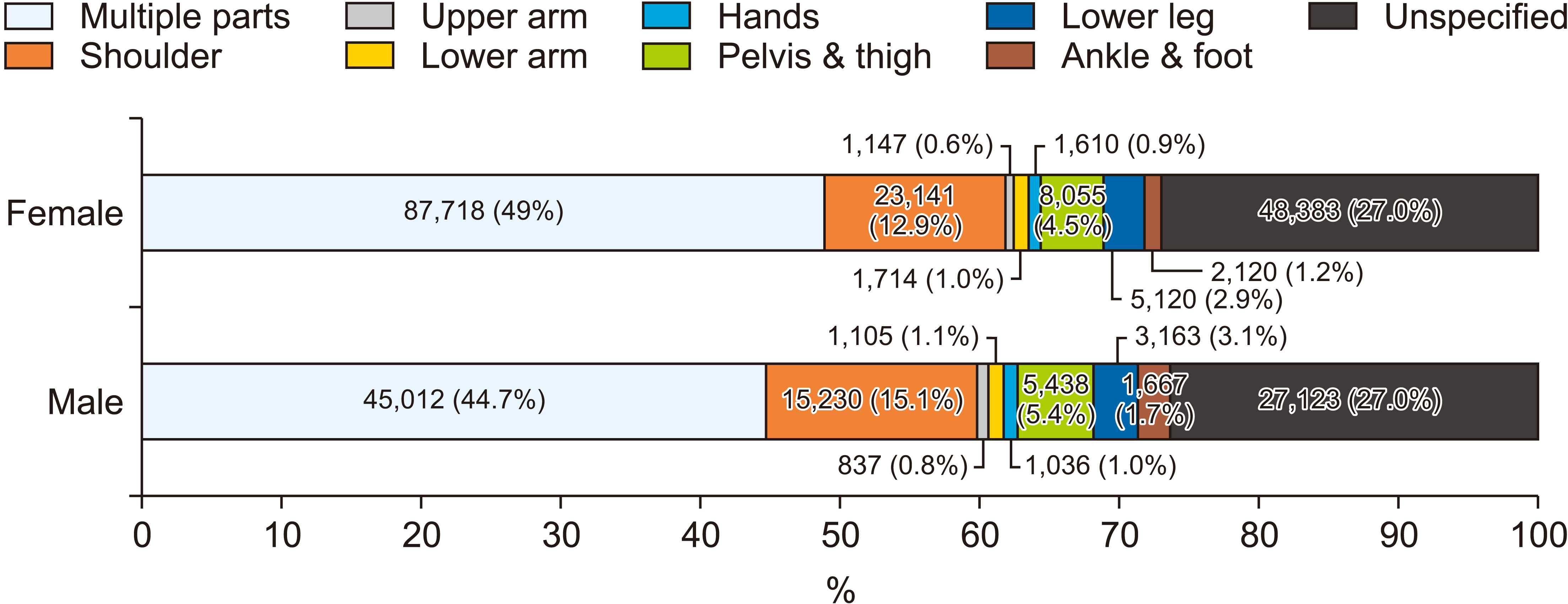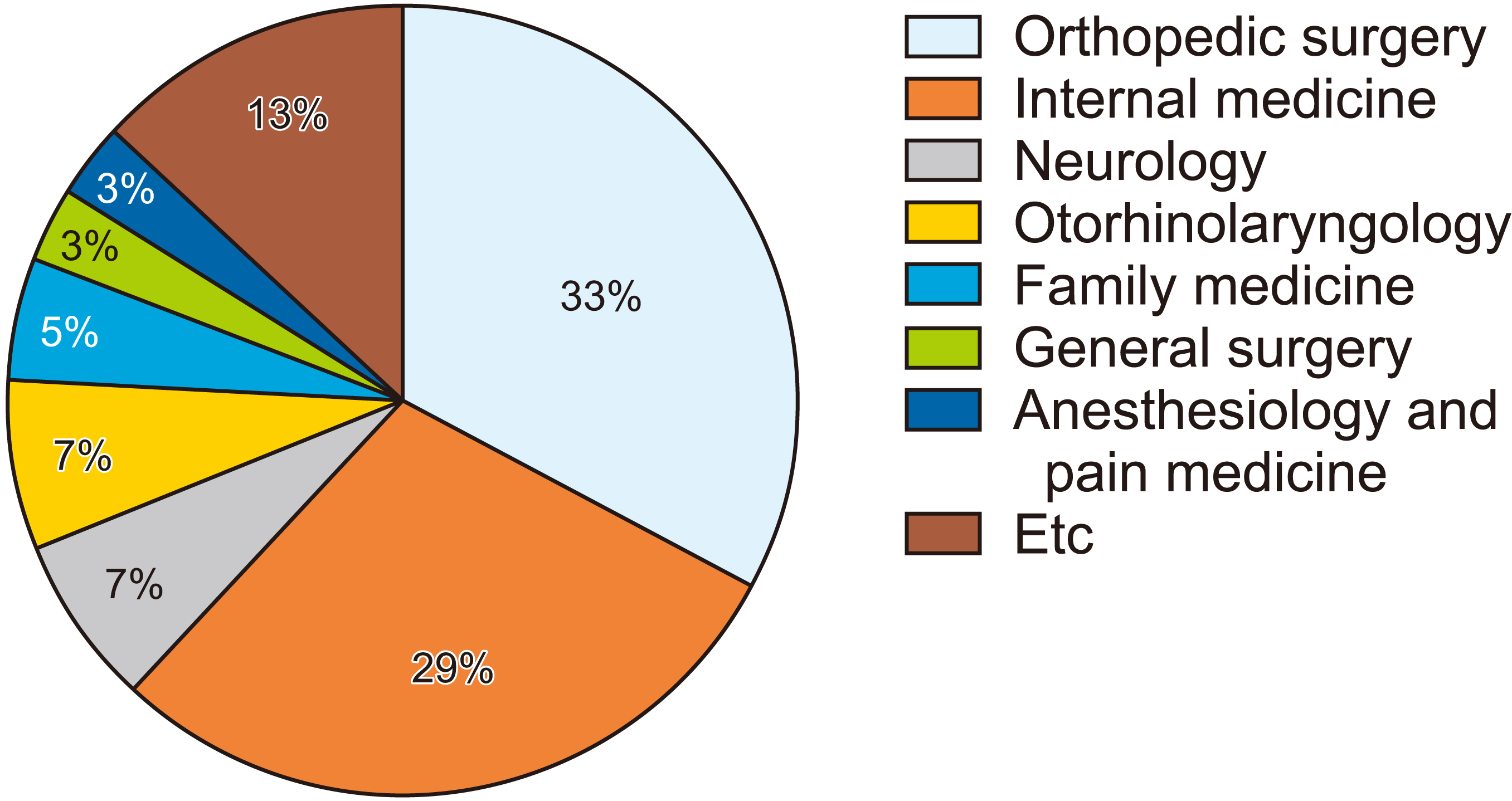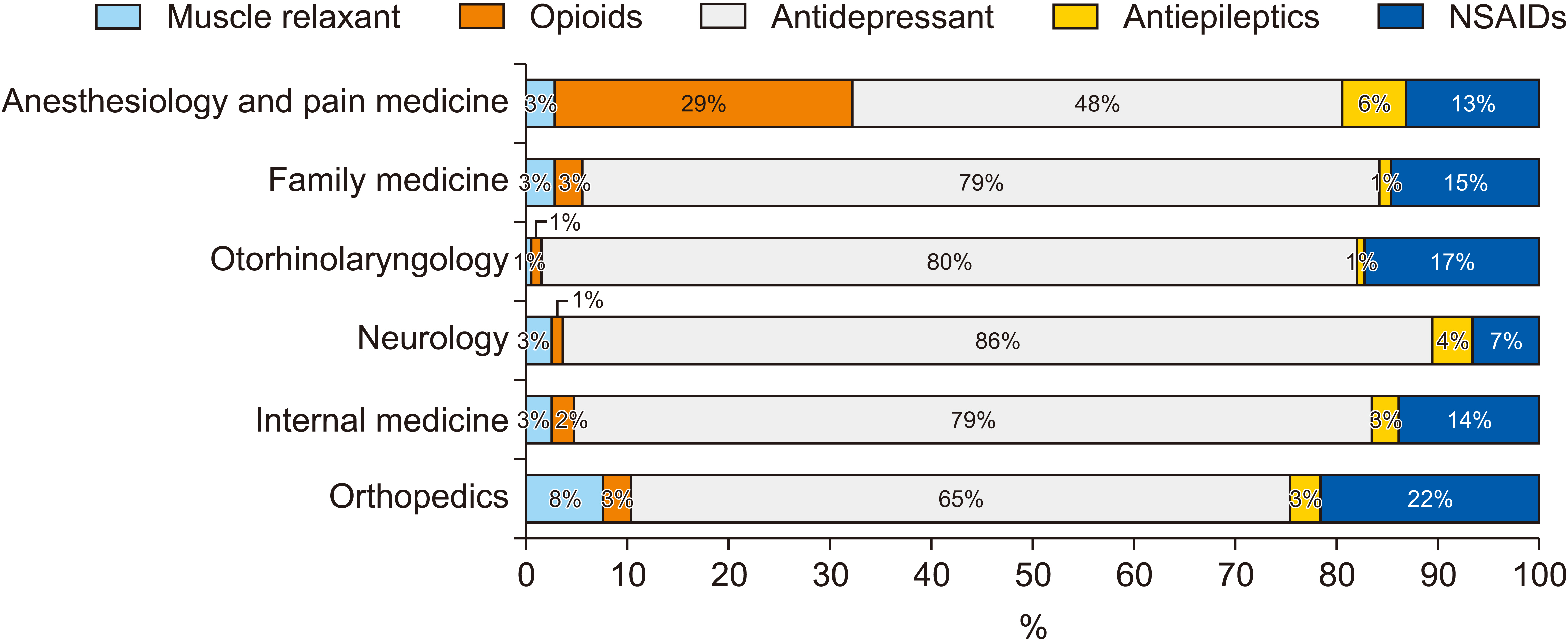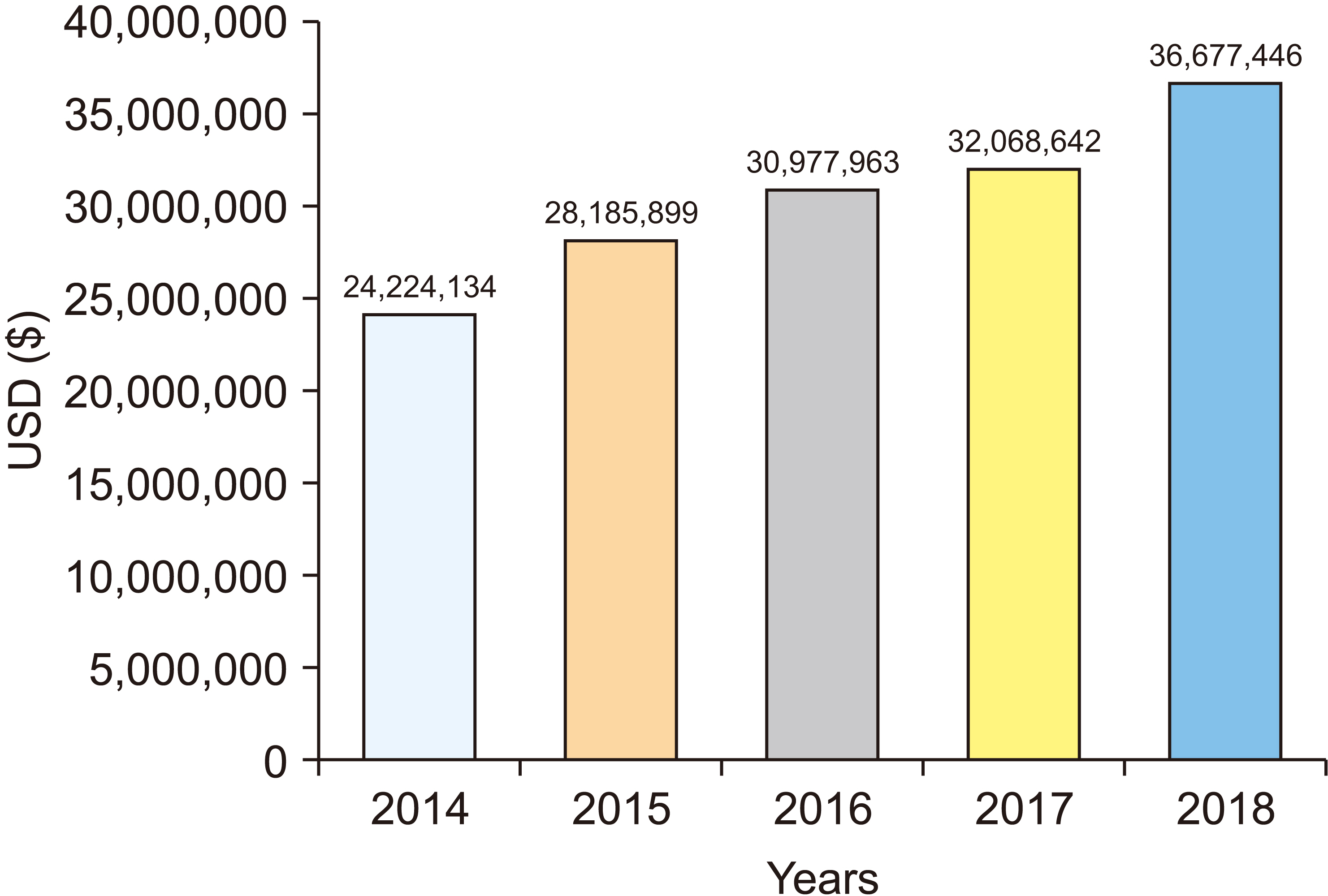Korean J Pain.
2023 Oct;36(4):458-464. 10.3344/kjp.23204.
The current status of fibromyalgia in Korea: an electronic population health data study in Korea
- Affiliations
-
- 1Department of Anesthesiology and Pain Medicine, Wonkwang University Hospital, Wonkwang University School of Medicine, Iksan, Korea
- 2Health Insurance Review and Assessment Service, Gwangju, Korea
- 3Department of Anatomy, Wonkwang University School of Medicine, Iksan, Korea
- 4Jesaeng-Euise Clinical Anatomy Center, Wonkwang University School of Medicine, Iksan, Korea
- 5Sarcopenia Total Solution Center, Wonkwang University School of Medicine, Iksan, Korea
- KMID: 2546708
- DOI: http://doi.org/10.3344/kjp.23204
Abstract
- Background
Fibromyalgia (FM) is a complex disorder characterized by widespread chronic pain and tenderness in the muscles, ligaments, and soft tissues. It is a chronic pain condition often accompanied by other symptoms and comorbidities. To effectively manage FM, it is crucial to obtain fundamental epidemiological data pertaining to the target population. Therefore, this study was conducted to elucidate the epidemiological characteristics of FM in the Korean population.
Methods
Population-based medical data of 51,276,314 subscribers to the National Health Insurance Service of Korea from 2014 to 2018 were used in this study.
Results
The overall incidence of FM ranged from 441 (2014) to 541 (2018) cases per 100,000 person-years, with a higher prevalence observed among female patients compared to male patients. The incidence gradually increased until middle age, followed by a decrease. The highest incidence rates were observed in the fifth decade of life for females and the sixth decade of life for males. When categorizing the affected parts of the body, the shoulder region was observed to be the most frequently affected. A comparison of the drug prescriptions based on medical specialty showed that antidepressants were the most commonly prescribed medications. The management of FM leads to consistent increases in medical expenses, regional disparities, and variations in prescription patterns across different medical specialties.
Conclusions
The findings of this study will not only contribute to the understanding of FM characteristics but also provide a vital foundation for efficient management of FM in Korea.
Keyword
Figure
Reference
-
1. Chinn S, Caldwell W, Gritsenko K. 2016; Fibromyalgia pathogenesis and treatment options update. Curr Pain Headache Rep. 20:25. DOI: 10.1007/s11916-016-0556-x. PMID: 26922414.
Article2. On AY, Tanigor G, Baydar DA. 2022; Relationships of autonomic dysfunction with disease severity and neuropathic pain features in fibromyalgia: is it really a sympathetically maintained neuropathic pain? Korean J Pain. 35:327–35. DOI: 10.3344/kjp.2022.35.3.327. PMID: 35768988. PMCID: PMC9251392.
Article3. Wolfe F, Smythe HA, Yunus MB, Bennett RM, Bombardier C, Goldenberg DL, et al. 1990; The American College of Rheumatology 1990 criteria for the classification of fibromyalgia. Report of the multicenter criteria committee. Arthritis Rheum. 33:160–72. DOI: 10.1002/art.1780330203. PMID: 2306288.4. Ghavidel-Parsa B, Bidari A, Hajiabbasi A, Shenavar I, Ghalehbaghi B, Sanaei O. 2019; Fibromyalgia diagnostic model derived from combination of American College of Rheumatology 1990 and 2011 criteria. Korean J Pain. 32:120–8. DOI: 10.3344/kjp.2019.32.2.120. PMID: 31091511. PMCID: PMC6549593.
Article5. Clauw DJ, Crofford LJ. 2003; Chronic widespread pain and fibromyalgia: what we know, and what we need to know. Best Pract Res Clin Rheumatol. 17:685–701. DOI: 10.1016/S1521-6942(03)00035-4. PMID: 12849719.
Article6. Carville SF, Arendt-Nielsen L, Bliddal H, Blotman F, Branco JC, Buskila D, et al. EULAR. 2008; EULAR evidence-based recommendations for the management of fibromyalgia syndrome. Ann Rheum Dis. 67:536–41. Erratum in: Ann Rheum Dis 2015; 74: 476. DOI: 10.1136/ard.2007.071522. PMID: 17644548.
Article7. Arnold LM, Clauw DJ, McCarberg BH. FibroCollaborative. 2011; Improving the recognition and diagnosis of fibromyalgia. Mayo Clin Proc. 86:457–64. DOI: 10.4065/mcp.2010.0738. PMID: 21531887. PMCID: PMC3084648.
Article8. Bidari A, Ghavidel Parsa B, Ghalehbaghi B. 2018; Challenges in fibromyalgia diagnosis: from meaning of symptoms to fibromyalgia labeling. Korean J Pain. 31:147–54. DOI: 10.3344/kjp.2018.31.3.147. PMID: 30013729. PMCID: PMC6037812.
Article9. Lee YS, Kim NH, Sohn HS, Choi KE, Shin HT. 2010; Development of drug utilization review guidelines for therapeutic duplication of antipyretics, analgesics, and anti-inflammatory drugs registered in Korea. Korean J Clin Pharm. 20:213–20. DOI: 10.1111/j.1365-2125.2010.03688.x. PMID: 20653674. PMCID: PMC2911551.10. Kim SH, Bae GR, Lim HS. 2006; Prevalence and risk factors of fibromyalgia syndrome and chronic widespread pain in two communities in Korea-first report in Korean. J Rheum Dis. 13:18–25.11. Lee HJ, Choi E, Nahm FS, Choi SS, Kim YH, Moon JY, et al. 2018; Prevalence of fibromyalgia in fourteen Korean tertiary care university hospital pain clinics. J Pain Res. 11:2417–23. DOI: 10.2147/JPR.S172221. PMID: 30425555. PMCID: PMC6200436.
Article12. Forseth KO, Gran JT, Husby G. 1997; A population study of the incidence of fibromyalgia among women aged 26-55 yr. Br J Rheumatol. 36:1318–23. DOI: 10.1093/rheumatology/36.12.1318. PMID: 9448594.13. Weir PT, Harlan GA, Nkoy FL, Jones SS, Hegmann KT, Gren LH, et al. 2006; The incidence of fibromyalgia and its associated comorbidities: a population-based retrospective cohort study based on International Classification of Diseases, 9th Revision codes. J Clin Rheumatol. 12:124–8. DOI: 10.1097/01.rhu.0000221817.46231.18. PMID: 16755239.14. Wolfe F, Walitt B, Perrot S, Rasker JJ, Häuser W. 2018; Fibromyalgia diagnosis and biased assessment: sex, prevalence and bias. PLoS One. 13:e0203755. DOI: 10.1371/journal.pone.0203755. PMID: 30212526. PMCID: PMC6136749. PMID: 7efc1b54276c4e899936bf5ac281c9d4.
Article15. Hadker N, Garg S, Chandran AB, Crean SM, McNett M, Silverman SL. 2011; Primary care physicians' perceptions of the challenges and barriers in the timely diagnosis, treatment and management of fibromyalgia. Pain Res Manag. 16:440–4. DOI: 10.1155/2011/367059. PMID: 22184554. PMCID: PMC3298044. PMID: 324257ba792f4c5baf03ec07963cd25e.
Article16. Sommer C, Häuser W, Alten R, Petzke F, Späth M, Tölle T, et al. 2012; Drug therapy of fibromyalgia syndrome. Systematic review, meta-analysis and guideline. Schmerz. 26:297–310. German. DOI: 10.1007/s00482-012-1172-2. PMID: 22760463.17. Fitzcharles MA, Ste-Marie PA, Goldenberg DL, Pereira JX, Abbey S, Choinière M, et al. National Fibromyalgia Guideline Advisory Panel. 2013; 2012 Canadian Guidelines for the diagnosis and management of fibromyalgia syndrome: executive summary. Pain Res Manag. 18:119–26. DOI: 10.1155/2013/918216. PMID: 23748251. PMCID: PMC3673928. PMID: ce31f36534704cca87d5a6f9af66ba4e.
Article18. Macfarlane GJ, Kronisch C, Dean LE, Atzeni F, Häuser W, Fluß E, et al. 2017; EULAR revised recommendations for the management of fibromyalgia. Ann Rheum Dis. 76:318–28. DOI: 10.1136/annrheumdis-2016-209724. PMID: 27377815.
Article19. Sarzi-Puttini P, Torta R, Marinangeli F, Biasi G, Spath M, Buskila D, et al. Italian Fibromyalgia Network. 2008; Fibromyalgia syndrome: the pharmacological treatment options. Reumatismo. 60 Suppl 1:50–8. DOI: 10.4081/reumatismo.2008.1s.50. PMID: 18852908. PMID: d1ac981c3af24c42bc079a4f1d4fe3fa.
Article20. Harris RE, Clauw DJ, Scott DJ, McLean SA, Gracely RH, Zubieta JK. 2007; Decreased central mu-opioid receptor availability in fibromyalgia. J Neurosci. 27:10000–6. DOI: 10.1523/JNEUROSCI.2849-07.2007. PMID: 17855614. PMCID: PMC6672650.21. Brummett CM, Janda AM, Schueller CM, Tsodikov A, Morris M, Williams DA, et al. 2013; Survey criteria for fibromyalgia independently predict increased postoperative opioid consumption after lower-extremity joint arthroplasty: a prospective, observational cohort study. Anesthesiology. 119:1434–43. DOI: 10.1097/ALN.0b013e3182a8eb1f. PMID: 24343289. PMCID: PMC3867739.22. Lee JH. 2023; Still a threatening opioid wave: it is time for the protagonist to step up! Korean J Pain. 36:1–3. DOI: 10.3344/kjp.22403. PMID: 36581596. PMCID: PMC9812690.
Article23. Goldenberg DL, Burckhardt C, Crofford L. 2004; Management of fibromyalgia syndrome. JAMA. 292:2388–95. DOI: 10.1001/jama.292.19.2388. PMID: 15547167.
Article24. McNett M, Goldenberg D, Schaefer C, Hufstader M, Baik R, Chandran A, et al. 2011; Treatment patterns among physician specialties in the management of fibromyalgia: results of a cross-sectional study in the United States. Curr Med Res Opin. 27:673–83. DOI: 10.1185/03007995.2011.553214. PMID: 21294700.
Article
- Full Text Links
- Actions
-
Cited
- CITED
-
- Close
- Share
- Similar articles
-
- Fibromyalgia: practical considerations for oral health care providers
- Neuropathic Pain and its Relationship With Fibromyalgia, Vitamin D Status and Medication Use in Patients With Ankylosing Spondylitis
- Clinical Terminologies: A Solution for Semantic Interoperability
- Fibromyalgia : an Overveiw
- The Association between Depressive Mood and Conventional and Electronic Cigarette Dual Use in Adult Male: Using Korea National Health and Nutrition Examination Survey

